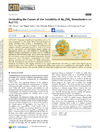Please use this identifier to cite or link to this item:
https://accedacris.ulpgc.es/jspui/handle/10553/106991
| DC Field | Value | Language |
|---|---|---|
| dc.contributor.author | Carro, Pilar | en_US |
| dc.contributor.author | Azofra, Luis Miguel | en_US |
| dc.contributor.author | Albrecht, Tim | en_US |
| dc.contributor.author | Salvarezza, Roberto C. | en_US |
| dc.contributor.author | Pensa, Evangelina | en_US |
| dc.date.accessioned | 2021-04-26T08:30:27Z | - |
| dc.date.available | 2021-04-26T08:30:27Z | - |
| dc.date.issued | 2021 | en_US |
| dc.identifier.issn | 0897-4756 | en_US |
| dc.identifier.other | Scopus | - |
| dc.identifier.uri | https://accedacris.ulpgc.es/handle/10553/106991 | - |
| dc.description.abstract | Properties of small metal nanoclusters rely on the exact arrangement of a few atoms. Minor structural changes can rapidly destabilize them, leading to disintegration. Here, we evaluate the energetic factors accounting for the stabilization and integrity of thiolate-capped gold nanoclusters (AuNCs). We found that the core-cohesive and shell-binding energies regulate the disintegration process on a solid substrate by investigating the different energetic contributions, as shown here in a combined experimental and theoretical study. As the AuNC size increases, the core-cohesive energy and shell stability (imposed by S-Au and hydrocarbon chain interactions) counterbalance the AuNC–substrate interaction and slow down the AuNC disintegration. Thus, the decomposition can not only be understood in terms of desorption and transfer of the capping molecules to the support substrate but conversely, as a whole where ligand and core interactions play a role. Taken together, our experimental and theoretical results serve as guidelines for enhancing the stability of AuNCs on solid-state devices, a key point for reliable nanotechnological applications such as heterogeneous catalysis and sensing. | en_US |
| dc.language | eng | en_US |
| dc.relation.ispartof | Chemistry of Materials | en_US |
| dc.source | Chemistry of Materials [ISSN 0897-4756], v. 33 (9), p. 3428–3435, (Abril 2021) | en_US |
| dc.subject | 2303 Química inorgánica | en_US |
| dc.subject | 331208 Propiedades de los materiales | en_US |
| dc.title | Unraveling the Causes of the Instability of Au n(SR)x Nanoclusters on Au(111) | en_US |
| dc.type | info:eu-repo/semantics/article | en_US |
| dc.type | Article | en_US |
| dc.identifier.doi | 10.1021/acs.chemmater.1c00816 | en_US |
| dc.identifier.scopus | 85106427808 | - |
| dc.contributor.orcid | 0000-0001-8073-9857 | - |
| dc.contributor.orcid | 0000-0003-4974-1670 | - |
| dc.contributor.orcid | 0000-0001-6085-3206 | - |
| dc.contributor.orcid | NO DATA | - |
| dc.contributor.orcid | 0000-0003-1090-0830 | - |
| dc.contributor.authorscopusid | 6603386988 | - |
| dc.contributor.authorscopusid | 55142490200 | - |
| dc.contributor.authorscopusid | 57223905383 | - |
| dc.contributor.authorscopusid | 7006787894 | - |
| dc.contributor.authorscopusid | 36468984700 | - |
| dc.identifier.eissn | 1520-5002 | - |
| dc.description.lastpage | 3435 | en_US |
| dc.description.firstpage | 3428 | en_US |
| dc.investigacion | Ciencias | en_US |
| dc.type2 | Artículo | en_US |
| dc.description.numberofpages | 8 | en_US |
| dc.utils.revision | Sí | en_US |
| dc.date.coverdate | Abril 2021 | en_US |
| dc.identifier.ulpgc | Sí | en_US |
| dc.contributor.buulpgc | BU-BAS | en_US |
| dc.description.sjr | 2,93 | |
| dc.description.jcr | 10,508 | |
| dc.description.sjrq | Q1 | |
| dc.description.jcrq | Q1 | |
| dc.description.scie | SCIE | |
| dc.description.miaricds | 11,0 | |
| item.fulltext | Con texto completo | - |
| item.grantfulltext | open | - |
| crisitem.author.dept | GIR IUNAT: Fotocatálisis y espectroscopía para aplicaciones medioambientales. | - |
| crisitem.author.dept | IU de Estudios Ambientales y Recursos Naturales | - |
| crisitem.author.orcid | 0000-0003-4974-1670 | - |
| crisitem.author.parentorg | IU de Estudios Ambientales y Recursos Naturales | - |
| crisitem.author.fullName | Azofra Mesa, Luis Miguel | - |
| Appears in Collections: | Artículos | |
SCOPUSTM
Citations
4
checked on Jun 8, 2025
WEB OF SCIENCETM
Citations
4
checked on Jun 8, 2025
Page view(s)
123
checked on Sep 7, 2024
Download(s)
193
checked on Sep 7, 2024
Google ScholarTM
Check
Altmetric
Share
Export metadata
Items in accedaCRIS are protected by copyright, with all rights reserved, unless otherwise indicated.
